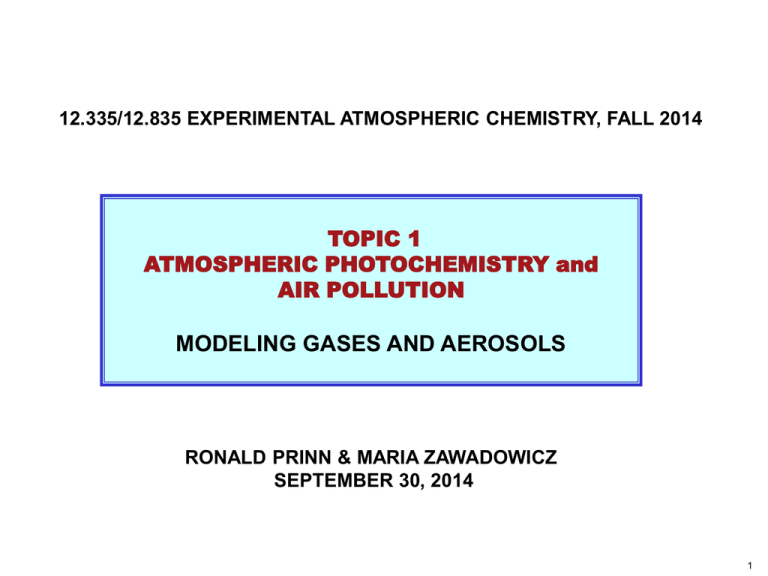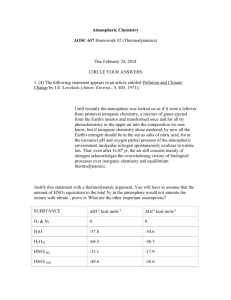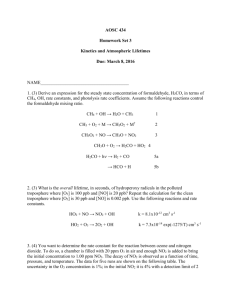
12.335/12.835 EXPERIMENTAL ATMOSPHERIC CHEMISTRY, FALL 2014
TOPIC 1
ATMOSPHERIC PHOTOCHEMISTRY and
AIR POLLUTION
MODELING GASES AND AEROSOLS
RONALD PRINN & MARIA ZAWADOWICZ
SEPTEMBER 30, 2014
1
GASEOUS CHEMICAL RATE EXPRESSIONS IN MODELS
2
3
Summary of gaseous chemical rate expressions for
production and loss of species i including surface
sources and sinks:
(1) Ji[i] where Ji can be derived from UV
measurements
(1) kij[i][j] where kij is given
(1) lijm[i][j][m] where lijm is given
surface = w
(2) i sink
dep[i] where wdep is given
surface either given or estimated from model(1) i emissions
measurement comparison
4
AEROSOL PHYSICAL RATE EXPRESSIONS IN MODELS
dN k
= Rate of change of aerosol number density
dt
(with size between k and k + dk)
= Emission (surface and in situ)
+ Condensation of precursor gases
+ Complete evaporation of water from cloud droplets
+ Coagulation of smaller aerosols
+ Fragmentation of larger aerosols
± Sedimentation (net into & out of layer)
- Coagulation with any other aerosols
-
Coalescence (into water droplets)
Fragmentation by collisions with other aerosols
Deposition (all surfaces)
Rainout (to surface)
"Activation" to form cloud droplets
dN coag
kcoag N * N
dt
dN coal
kcoal N ** N
dt
dN dep
vdep N
dt
dN rain
N
rain
dt
etc.
5
DIAGNOSTIC EQUATIONS ASSUME A PHOTOCHEMICAL STEADY
STATE (PSSA)
Recall PSSA equations ignore influence of meteorology so valid only when wind speed u ~ 0
In PSSA: rate of loss (Li) = rate of production (Pi)
e. g. for the ozone chemical reaction set including NOx and HOx chemistry:
(1) NO + O3 -> NO2 + O2
(2) NO2 + hv -> NO + O
(3) O + O2 + M -> O3 + M
(4) O3 + hv -> O2 + O
(5) NO2 + OH + M -> HNO3 + M
(6) OH + CO -> H + CO2
(7) H + O2 + M -> HO2 + M
(8) HO2 + NO -> OH + NO2
We have for NO, HO2, H and O concentrations:
k1[O3][NO] + k8[HO2][NO] = J2[NO2]
i.e. [NO2]/[NO] = (k1[O3] + k8[HO2])/J2
k8[HO2][NO] = l7[H][O2][M]
i.e. [HO2] /[H] = l7[O2][M]/(k8[NO])
l7[H][O2][M]= k6[CO][OH]
i.e. [H]/[OH] = k6[CO]/(l7[O2][M])
l3[O][O2][ M]= J2[NO2] + J4[O3]
i.e. [O]/[O3] = (J2[NO2]/[O3] + J4)/(l3[O2][M])
Recall the PSSA analytical solution when we consider NOx but not HOx chemistry:
6
PROGNOSTIC (CONTINUITY) EQUATIONS TAKE
ACCOUNT OF PROGNOSTIC CHEMISTRY AND
TRANSPORT BY WINDS
[i]
d[i]
v[i]
u[i]
[
]chem
w[i]
dt
t
x
y
z
The local change
(rate of accumulation)
of i in the box
Actual production
or destruction of i
within the box
Change in [i] due to loss to downstream
boxes or arrival from an upstream
box (called advection or convection)
HYBRID CHEMICAL KINETIC EQUATIONS
(1) Use prognostic equations, (d[i]/dt) chemistry = Pi - Li) for long lived
species like [Ox] (=[O] + [O3]) and [NOx](=[NO + [NO2])
(2) Use diagnostic (steady state) equations, Pi = Li for short lived
species like O, NO, H and HO2 to provide the ratios [O]/[O3],
[NO2]/[NO], [HO2]/[H] and [H]/[OH]
(3) Assume [HOx] = [H] + [OH] + [HO2] ~ [HO2] is given
(4) Use observed values for [CO]
(5) Use lowest observed [NOx] and [O3] as boundary conditions for
NOx and Ox
7
A SIMPLE PHOTOCHEMICAL BOX MODEL
to simulate time-varying concentrations of trace gases and
aerosols using the PROGNOSTIC CONTINUITY EQUATION
u upwind
d[i]box
surface
[i]box ([i]top [i]box ) / exchange (surface
Pi Li [i]
i,emissions
i,sin k ) /Z
dt
X
8
EXAMPLE: ANALYTICAL SOLUTION TO THE CONTINUITY EQUATION RELATING
MOLE FRACTION (Xi) OF i=NO (as a function of distance (x) from a source
region) ASSUMING A CONSTANT HORIZONTAL WIND SPEED (u), A
PHOTOCHEMICAL STEADY-STATE, A ONE DIMENSIONAL (x AXIS) MODEL and
LOSS DUE TO NO + O3 NO2 + O2 WITH [O3] >> [NO]
STEADY STATE
STEADY
ST
:
d[i]downwind
d[i]
dX
Pi Li [M]u i
0 Pi Li u
dt
dx
dx
(X i = [i]/[M] = mole _ fraction)
Define τ(NO) = 1/(k[O3]
where k is rate constant
for reaction of NO (e.g.
from engine exhausts)
with ozone
9
INCORPORATING METEOROLOGY IN THE BOX MODEL
1. USE THE u MEASUREMENTS TO ALIGN THE MODEL x AXIS AND USE IN THE
BOX MODEL ADVECTION TERMS.
2. USE THE T & u MEASUREMENTS TO CALCULATE A RICHARDSON NUMBER TO
HELP CHOOSE SUITABLE texchange VALUES.
T OP OF BOUNDARY LAYER
.
© Cory Cripe. Some rights reserved. License: CC BY-NC
3.0. This content is excluded from our Creative
Commons license. For more information, see
http://ocw.mit.edu/help/faq-fair-use/.
3. USE TEMPERATURE SOUNDINGS OR HAZE LAYER HEIGHT TO ESTIMATE Z
10
COMPONENTS OF ATMOSPHERIC CHEMISTRY MODELS
DYNAMICAL EQUATIONS
Winds , Eddy diffusion coefficients
MASS CONTINUITY EQUATION
MOMENTUM EQUATIONS
Temperature
THERMODYNAMIC EQUATION
CHEMICAL
Rates
for
Heating
= Pi - Li -
EQUATIONS
U.
V
r
Fo
o
ph
Flu
xe
s
.([i]V)
~
n
tio
ia
oc
ss
di s
to ate
r
{
∂t
∆
RADIATION
For
Unpredicted
green house
gases use
scenarios or
extra polations
For Source gases
use predictions,
extra polations
or scenarios
∂ [i]
Concentrations
(O3, etc.)
Rates for Chemistry
{
CONTINUITY EQUATIONS
TRANSPORT,
CHEMISTRY AND
RADIATION
COMPONENTS
IN COMPLEX 3D
MODELS
Interactions Between Air Pollution and Climate
Stratosphere
UV
O2
NO2
O3
O2
UV
OH
NO
HNO3
O( D)
OH
N 2O
Lightning
H2O
CO2
Hydrosphere
H2SO4
HO2
O2
1
CO
OH
CH4
CO2
OH
CFCs
BC
SO2
Biosphere & Human Activity
Greenhouse Gases
Primary & Secondary Pollutants
Absorbing Aerosols (BC)
Reactive Free Radical/Atom
Less Reactive Radicals
Reflective Aerosols
Figure by MIT OpenCourseWare.
11
The spatial
grid
We divide the earth’s
atmosphere into a
finite number of boxes
(grid cells).
Assume that each
variable has the same
value throughout the
box.
Write a budget for each
each box, defining the
changes within the
box, and the flows
between the boxes.
© John Wiley & Sons, Inc. All rights reserved. This content is excluded from our Creative
Commons license. For more information, see http://ocw.mit.edu/help/faq-fair-use/.
12
INTERSPECIES (CO-PM) CORRELATIONS
[Note Expect PM10 > PM2.5 > PM1]
13
N
W
S
E
N
USE iPHONE
COMPAS
S TO
INTEPRET
RE BLDG
54
CO - WIND (DIRECTION, SPEED) CORRELATIONS
14
N
W
S
E
N
USE iPHONE
COMPAS
S TO
INTEPRET
RE BLDG
54
PM - WIND (DIRECTION, SPEED) CORRELATIONS
15
[Note Expect O3 > 40ppb ]
[Note Expect NOx > NO]
16
N
W
S
E
N
[Note Expect O3 > 40ppb ]
[Note Expect NOx > NO]
17
MIT OpenCourseWare
http://ocw.mit.edu
12.335 / 12.835 Experimental Atmospheric Chemistry
Fall 2014
For information about citing these materials or our Terms of Use, visit: http://ocw.mit.edu/terms.



